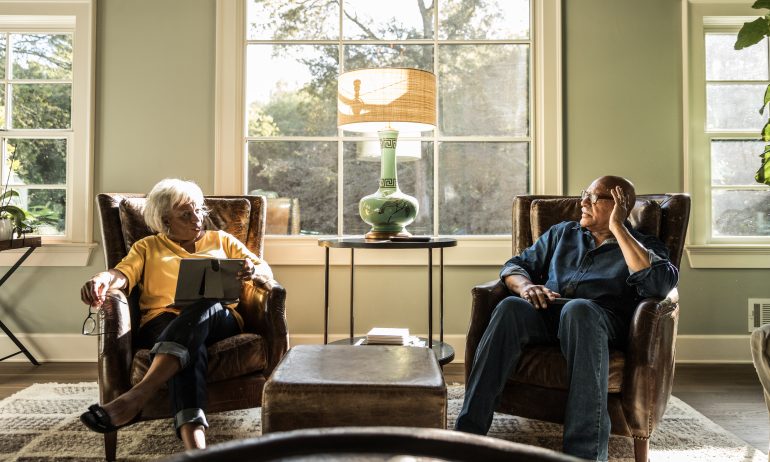Start Early to Get Your House Retirement-Ready

Many or all of the products featured here are from our partners who compensate us. This influences which products we write about and where and how the product appears on a page. However, this does not influence our evaluations. Our opinions are our own. Here is a list of our partners and here's how we make money.
Many people want to remain in their homes after they retire rather than move to a senior living facility or community. Unfortunately, most homes aren't set up to help us age safely and affordably.
If your goal is to “age in place,” some early preparation could help make that possible — or point to better alternatives.
“Somewhere in your 50s, hopefully, you're starting to think seriously about are you going to be able to stay in the house you're in? Or are you going to need to make changes?” says DeDe Jones, a certified financial planner in Denver.
Consider what you need to change
Start by thinking about how you would live in your home if you had less mobility, less energy and potentially less money.
Unexpected expenses for major home repairs or upgrades were the most commonly reported financial shocks experienced by retirees, according to a 2015 study by the Society of Actuaries. Those big-ticket costs can be devastating on a fixed income. The society recommends a home inspection before retirement so you can identify and budget for those costs. But you also could schedule some of the expensive stuff — replacing a roof, for instance, or upgrading the heat and air conditioning system — while you’re still working.
Likewise, investments in energy efficiency could help you avoid big bills when you’re less able to afford them. Adding insulation, installing a smart thermostat and choosing energy-efficient appliances can help. In sunnier climates, solar panels can dramatically reduce your energy costs.
Consider upkeep, as well. You might want to replace a labor-intensive grass yard and planting beds with lower-maintenance landscaping. You could swap out siding that needs to be painted every few years with a more durable option, such as vinyl, fiber cement or modified wood. Decluttering can make your place easier to navigate and to clean.
Build your equity
You may still face big bills or have trouble making ends meet in retirement. In that case, your home’s equity could be helpful. You could access your home’s value by selling it, using a reverse mortgage or getting a home equity line of credit.
But you can’t tap equity you don’t have. In 2016, 46% of homeowners age 65 to 79 still had mortgage debt, according to Harvard University’s Joint Center for Housing Studies. The median balance owed was $77,000.
A mortgage in retirement isn’t ideal for many people, financial planners say. Few people get much if any tax benefit from their mortgages, and having to make the payments can cause people to deplete their retirement savings more rapidly.
Planners say you shouldn’t prioritize paying off your mortgage over saving for retirement and for emergencies. And you probably shouldn’t take money from retirement funds to pay off a mortgage. But once you’re on track with your savings goals, you could make extra principal payments to pay down the loan more rapidly. You also can avoid having a mortgage in retirement by opting for shorter loans when you refinance. If you're 50, for example, you might choose a 15-year loan over one that lasts 30 years.
Assess accessibility
Consider incorporating accessibility features into any planned renovations. Grab bars in bathrooms, lever-style handles on doors and faucets, and rocker-style light switches (preferably accessible from a wheelchair) are relatively low-cost upgrades, for example. Costlier changes include widening doorways and hallways, adding a curbless shower, installing non-slip flooring and creating a zero-step entry.
Ideally, your home would have just one level, but a home with stairs can work if it has a bedroom and full bath on the entry level. If that’s your situation, you could focus your renovations on making those spaces accessible rather than trying to remake your whole house.
Sometimes there’s simply too much that needs to be done or your home has features you can’t affordably modify. Even if you think you can manage a bunch of stairs or a home that’s far from your neighbors, your living situation could worry your loved ones, Jones notes.
“Moving might give you the chance to live closer to your support system,” she says. “Makes it easier on them, makes it easier on you.”
Certified financial planner Melissa Brennan of Plano, Texas, says she and her husband are at least a decade away from retirement and still have two teenagers at home. But they recently traded a two-story, four-bedroom, four-bath home on an oversized lot for a smaller, one-story house with tiled floors and a wheelchair-accessible bathroom.
Brennan said they were mindful of the problems their parents had navigating their houses as they aged, and the bigger house was already seeming like more of a burden than a blessing.
“We don't want to spend the rest of our lives maintaining this ginormous house that we don't need,” Brennan says.
This article was written by NerdWallet and was originally published by The Associated Press.

